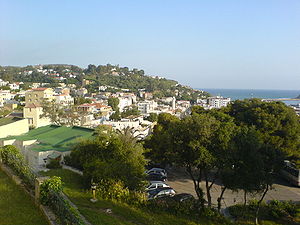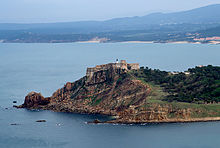Tabarka
Tabarka
طبرقة | |
|---|---|
 | |
| Country | |
| Governorate | Jendouba Governorate |
| Elevation | 15.4 ft (4.7 m) |
| Population (2014) | |
| • City | 17,425 |
| • Density | 10,080/sq mi (3,893/km2) |
| • Urban | 41,293 |
| • Urban density | 80/sq mi (31/km2) |
| • Metro | 48.993 |
| • Metro density | 170/sq mi (64/km2) |
| Time zone | UTC1 (CET) |
| Postal Code | 8110 |
Tabarka (Template:Lang-ar , Phoenician Ṭabarqa, Thabraca in Latin,[1][2] also called Tbarga by locals) is a coastal town located in north-western Tunisia, at about 36°57′16″N 8°45′29″E / 36.95444°N 8.75806°E, close to the border with Algeria. It has been famous for its coral fishing, the Coral Festival of underwater photography and the annual jazz festival. Tabarka's history is a colorful mosaic of Phoenician, Roman, Arabic and Turkish civilizations. The town is dominated by an offshore rock on which is built a Genoese castle. Nationalist leader Habib Bourguiba, later to become president of post-independence Tunisia, was exiled here by the French colonial authorities in 1952.
History

Although older sources placed Thabraca within the Roman province of Numidia, recent ones agree in placing it in the Roman province of Africa, known also as Africa Proconsularis.[3][4][5][6] It was a Roman colony. It was connected by a road with Simitthu, to which it served as a port for the exportation of its famous marbles.
At Thabraca the rebellious Roman official Gildo, the brother of Firmus, committed suicide. Under the Vandal king Gaiseric it had a monastery for men and one for women.


In 1540 the island of the same name which lies at a distance of about 365 yards overlooking the city, was given by the Ottoman Turk bey of Tunis in concession to the Genoese family of Lomellini. The Genoese were in the service of Spain during 1553 at the request of Carlos V of Castile and Aragon that was interested in coral fishing. The Lomellini were part of the circle of Andrea Doria, Doge of Genoa and were related to parental ties to the family Grimaldi (XVI century). Here you can still see the ruins of a fortress stronghold, a church, and some Genoese buildings. The Genoese maintained a fortress garrison there from 1540 to 1742. The Lomellini were part of the inner circle of Andrea Doria, Doge of Genoa and were related to parental ties to the family Grimaldi (XVI century). The grant was likely due to a never revealed but likely ransom for the release of the pirate Turkish Dragut, captured in 1540 by Giannettino Doria, nephew of Andrea Doria. The Lomellini colonized Tabarca with a group of inhabitants of Pegli, near Genoa, where he had various properties and a huge palace resort. The community of pegliesi lived in Tabarka for several centuries. In 1738 due to the exhaustion of the coral reefs and the deterioration of relations with the Arab population a large group of Tabarkini moved to the Sardinia island of San Pietro, then uninhabited, where they founded a new town of Carloforte. The transfer was made possible thanks to the King of Sardinia, Carlo Emanuele III of Savoy to colonize those lands belonging to Sardinia which were not yet inhabited. The name of Carlisle was chosen in honor of the sovereign. At Tabarka, the ruins consists of a pit once used as a church and some fragments of walls which belonged to Christian buildings. There were also two Ottoman Turkish fortresses, one of which has been repaired.

In 1741 the Genoese fortress surrendered to the (nominally Ottoman, de facto autonomous) Bey of Tunis. Part of the population was moved to the Sardinian island of San Pietro and the town of Calasetta on the adjacent Island of Sant'Antioco, whose population still speaks a variant of Genoese dialect originating from Tabarka. Others were moved to the Spanish island of New Tabarca.[7]
Under French colonial rule it was annexed to the civil district of Souk el-Arba, now in the Tunisian governorate of Jendouba, and a rather important fishing centre. Tabarka Jazz Festival was established in 1973.
Ecclesiastical history
Thabraca became a Christian bishopric that is no longer a residential see but is included in the Catholic Church's list of titular sees.[6]

The city contains several Christian cemeteries, many of the tombs covered with curious mosaics. An inscription (C.I.L., VIII, 173-82) mentions the cult of the martyr Anastasia and her companions.
Bishops
The bishops of Thabraca, who met with the other bishops of Proconsular Africa, included:
- Victoricus, at the Council of Carthage (256);
- Rusticianus, at the conference of Carthage in 411, where his competitor was the Donatist Charentius; he also signed in 416 the letter from the council of Proconsular Africa to Pope Innocent I;
- Clarissimus, who in 646 signed the letter from the same Council to Patriarch Paul II of Constantinople against the Monothelites.
Titular bishops
- Pierre Brigot, (22 Jan 1755 Appointed - 8 Nov 1791)
- St. Louis Gabriel Taurin Dufresse, (24 Jul 1798 Appointed - 14 Sep 1815)
- Edward Kernan (6 Feb 1818 Appointed - 19 Nov 1824)
- Rémi Gaulin † (10 May 1833 Appointed - 14 Jan 1840 Succeeded, Bishop of Kingston, Ontario)
- Bernardino di Milia, (27 Mar 1884 Appointed - 4 Jun 1891)
- Antonin Guillermain, (12 Jan 1895 Appointed - 14 Jul 1896)
- Henri Streicher, (1 Feb 1897 Appointed - 2 Jun 1933)
- Auguste-Joseph-Marie Cogneau (23 Jun 1933 Appointed - 12 Apr 1952)
- Georges Kettel, (24 Mar 1953 Appointed - 10 Nov 1959)
- Charles Quentin Bertram Olwell, (19 Jan 1961 Appointed - 30 Jan 1972)
- Antônio Agostinho Marochi (27 Sep 1973 Appointed - 2 Feb 1976)
- Sebastian Acol Dalis (18 Nov 1987 Appointed - 27 Oct 2004 Died)
- Pedro Joaquin Hernández Cantarero, (12 Feb 2005 Appointed - )
Weather
Climate
The weather in Tabarka is usually unstable depending on the year. Summer is mostly mild and dry since it barely rains in July and August. The average temperatures for this season is 28.2 °C (82.8 °F). As for winter, it is mostly rainy and cold. Some snow can be seen during this time of the year. The average temperature for this season is 7.4 °C (45.3 °F).
| Climate data for Tabarka 1981–2010 | |||||||||||||
|---|---|---|---|---|---|---|---|---|---|---|---|---|---|
| Month | Jan | Feb | Mar | Apr | May | Jun | Jul | Aug | Sep | Oct | Nov | Dec | Year |
| Record high °C (°F) | 25.6 (78.1) |
24 (75) |
28.6 (83.5) |
37 (99) |
41.3 (106.3) |
43.1 (109.6) |
44.5 (112.1) |
44.3 (111.7) |
43.2 (109.8) |
40 (104) |
27.7 (81.9) |
23.7 (74.7) |
44.5 (112.1) |
| Mean daily maximum °C (°F) | 14.1 (57.4) |
15.8 (60.4) |
17.9 (64.2) |
20.7 (69.3) |
23.6 (74.5) |
29.3 (84.7) |
39.6 (103.3) |
29.4 (84.9) |
29.7 (85.5) |
25.3 (77.5) |
20.9 (69.6) |
16.3 (61.3) |
23.6 (74.4) |
| Daily mean °C (°F) | 7.4 (45.3) |
11.7 (53.1) |
13.5 (56.3) |
15.5 (59.9) |
18.4 (65.1) |
23 (73) |
28.4 (83.1) |
28 (82) |
26.5 (79.7) |
18.5 (65.3) |
11.1 (52.0) |
7.1 (44.8) |
17.4 (63.3) |
| Mean daily minimum °C (°F) | 2.6 (36.7) |
4.6 (40.3) |
9.1 (48.4) |
10.4 (50.7) |
13.3 (55.9) |
17.7 (63.9) |
23 (73) |
22.6 (72.7) |
19.3 (66.7) |
11.7 (53.1) |
7.4 (45.3) |
4.4 (39.9) |
12.2 (53.9) |
| Record low °C (°F) | −7.4 (18.7) |
−5.5 (22.1) |
−2.3 (27.9) |
−1.7 (28.9) |
0 (32) |
9 (48) |
10.1 (50.2) |
11.8 (53.2) |
7 (45) |
−5 (23) |
−4.8 (23.4) |
−4.7 (23.5) |
−7.4 (18.7) |
| Average precipitation mm (inches) | 236 (9.3) |
233 (9.2) |
80 (3.1) |
61 (2.4) |
37 (1.5) |
15 (0.6) |
3 (0.1) |
6 (0.2) |
43 (1.7) |
89 (3.5) |
112 (4.4) |
212 (8.3) |
1,127 (44.3) |
| Average snowfall cm (inches) | 3.3 (1.3) |
3.1 (1.2) |
1.2 (0.5) |
0 (0) |
0 (0) |
0 (0) |
0 (0) |
0 (0) |
0 (0) |
0 (0) |
0 (0) |
2.8 (1.1) |
10.4 (4.1) |
| Average rainy days | 14 | 12 | 11 | 8 | 4 | 2 | 1 | 3 | 5 | 10 | 14 | 11 | 95 |
| Mean monthly sunshine hours | 78.5 | 82.4 | 120.2 | 135.4 | 157.6 | 210.2 | 250.6 | 234.2 | 112.2 | 94.0 | 89.8 | 81.2 | 1,646.3 |
| Source 1: Climate-Data.org,[8] Weather2Travel for rainy days and sunshine[9] | |||||||||||||
| Source 2: Voodoo Skies for record temperatures[10] | |||||||||||||


| Jan | Feb | Mar | Apr | May | Jun | Jul | Aug | Sep | Oct | Nov | Dec |
|---|---|---|---|---|---|---|---|---|---|---|---|
| 15 °C (59 °F) | 15 °C (59 °F) | 15 °C (59 °F) | 15 °C (59 °F) | 17 °C (63 °F) | 21 °C (70 °F) | 24 °C (75 °F) | 25 °C (77 °F) | 24 °C (75 °F) | 22 °C (72 °F) | 19 °C (66 °F) | 16 °C (61 °F) |
Transport
There is one airport in Tabarka that was named Airport 7 Novembre until the Tunisian revolution; it was then renamed Tabarka-Ain Draham International Airport.


See also
- Fossa regia
- Tabarka Rocks
- Genoese-Tabarka diaspora
References
- ^ "Charlton T. Lewis, Charles Short, A Latin Dictionary". web.archive.org. Retrieved 28 March 2016.
- ^ Chapot, V. (1928). The Roman World. Knopf. p. 385. ISBN 9780819603678. Retrieved 28 March 2016.
- ^ Hornblower, S.; Spawforth, A.; Eidinow, E. (2012). The Oxford Classical Dictionary. OUP Oxford. p. 33. ISBN 9780199545568. Retrieved 28 March 2016.
- ^ Conant, J. (2012). Staying Roman: Conquest and Identity in Africa and the Mediterranean, 439-700. Cambridge University Press. p. 48. ISBN 9780521196970. Retrieved 28 March 2016.
- ^ Saint Augustine; Rotelle, J.E.; Teske, R.J. (2001). Letters 1-99. New City Press. p. 264. ISBN 9781565481633. Retrieved 28 March 2016.
- ^ a b Annuario Pontificio 2013 (Libreria Editrice Vaticana, 2013, ISBN 978-88-209-9070-1), p. 979
- ^ Varela, Santiago (1983). "Nueva Tabarca / Nova Tabarca: 1. Generalidades / 1. Generalitats". Alicante / Alacant, Tabarca: Rutas de aproximación al patrimonio cultural valenciano / Rutes d'aproximació al patrimoni cultural valencià (in Spanish and Catalan). Juan Calduch; Joaquín Lara (graphic dessing). Servicio de patrimonio arquitectónico: Conselleria de Cultura, Educación y Ciencia: Generalidad Valenciana.
- ^ "Climate: Tabarka - Climate graph, Temperature graph, Climate table". Climate-Data.org. Retrieved 21 July 2014.
- ^ a b "Tabarka Climate and Weather Averages, Tunisia". Weather2Travel. Retrieved 19 July 2014.
- ^ "Tabarka, Tuisia". Voodoo Skies. Retrieved 19 July 2014.
External links
- Herbermann, Charles, ed. (1913). . Catholic Encyclopedia. New York: Robert Appleton Company.
- Tabarka.Com Tabarka Guide
- Tabarka.Org
- Tabarka Forum
- Tabarka Voyages
- Lexicorient
- WorldStatesmen-Tunisia
- Reading Room Manchester. "CWGC - Cemetery Details". cwgc.org. Retrieved 28 March 2016.
![]() This article incorporates text from a publication now in the public domain: Herbermann, Charles, ed. (1913). "Thabraca". Catholic Encyclopedia. New York: Robert Appleton Company.
This article incorporates text from a publication now in the public domain: Herbermann, Charles, ed. (1913). "Thabraca". Catholic Encyclopedia. New York: Robert Appleton Company.
